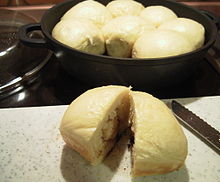food.wikisort.org - Dish
Dampfnudel (plural Dampfnudeln, lit. "steam-noodle"; Alsatian: Dampfnüdel) is a sort of white bread roll or sweet roll eaten as a meal or as a dessert in Germany, Austria[1] and in France (Alsace-Moselle). It is a typical dish in southern Germany.
This article needs additional citations for verification. (September 2016) |
 | |
| Type | Sweet bread |
|---|---|
| Place of origin | Germany and Alsace |
| Main ingredients | Flour, water, yeast, butter or margarine; sometimes eggs or sugar |


History

There are Dampfnudel city gates in Freckenfeld and Kandel, two towns in the Rhineland-Palatinate, in western Germany, very near the border with French Alsace.[citation needed] It is reputed that, during the Thirty Years' War, Swedish troops arrived at Freckenfeld and demanded ransom. Master baker Johannes Muck, with his wife and apprentice, made 1,286 Dampfnudeln to feed the soldiers, who then spared the village from further extortion and pillage.[2] The Dampfnudeltor (Dampfnudel gate) even features on the coat of arms of the municipality of Freckenfeld.
Ingredients and preparation
Dampfnudeln are made from a dough composed of white flour, water, yeast, salt, butter or margarine, and sometimes also eggs and a little sugar. The dough is formed into balls about the size of an egg or a fist, left to rise and then cooked in a closed pot, preferably a high-rimmed iron pan with a lid, with milk and butter (the Bavarian-style) or salt water and fat (the Rhineland-Palatinate style) until a golden-brown crust forms at the bottom after the liquid has evaporated. The tops remain white.
Serving
Dampfnudeln are typically served as a main course with savoury accompaniment such as cabbage, salad, gherkins, potato soup, lentil soup, or mushrooms in a béchamel sauce. They can also be served as a dessert with vanilla custard, jam, or boiled fruit. In Bavaria and the Palatinate, however, Dampfnudeln are traditionally served as the main dish even though they are normally served sweet in those regions.[citation needed]
See also
- Germknödel
- Buchteln
- Mantou (馒头; 饅頭; mántou; maan4 tau4)
- List of buns
- List of desserts
- Siopao
- List of steamed foods
- List of sweet breads
References
- N. F. Simpson. "Dampfbuchteln — Sweet Yeast Dumplings". Delicious Days. Retrieved October 1, 2016.
- "Freckenfelder Geschichte" [History of Freckenfeld] (PDF) (in German). Collective municipality of Kandel. p. 4. Retrieved 7 September 2016.
Further reading
- Helga Rosemann (2012). Dampfnudeln: Eine pfälzisch-bayerische Spezialität. Offenbach: Höma-Verlag. ISBN 978-3-937329-65-9.
На других языках
- [en] Dampfnudel
[ru] Дампфнудель
Дампфнудели (нем. Dampfnudel) — клёцки из дрожжевого теста, приготавливаемые в кастрюле на пару, одновременно жареные и паровые. Характерны для южнонемецкой и австрийской кухни, а также французского Эльзаса[1]. В немецкой и австрийской классификации относятся к мельшпайзе.Другой контент может иметь иную лицензию. Перед использованием материалов сайта WikiSort.org внимательно изучите правила лицензирования конкретных элементов наполнения сайта.
WikiSort.org - проект по пересортировке и дополнению контента Википедии